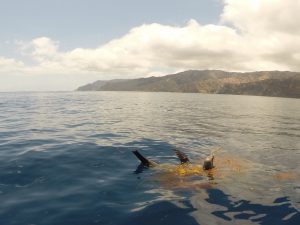
I want those of you who have ever been cold on a snorkel to raise your hands in the air…No really, raise your hands in air—that’s the best way to stay warm in the water. Don’t believe me? Just ask the sea lions. Sea lions are marine mammals, and therefore endothermic. This means that they control their own internal body heat separate from their ambient environment. Many marine mammals, including sea lions, keep their core around 100 ˚ F. This can pose some interesting dilemmas for marine mammals that live in waters MUCH colder than their internal temperature. There are many adaptations that sea lions have to maintain their core temperature in the water, both physiologically and behaviorally—this process is called thermoregulation.

One behavioral modification that California sea lions enact to stay warm in the water is something called “jughandling”. Have you ever seen a sea lion waving at you from in the water? Maybe you have while on your boat ride to Catalina, or if you kayaked around Bird Rock. What appears to us as an overly-friendly sea lion saying “hello”, is actually a behavioral form of thermoregulation. Sea lion front flippers are not covered in fur, and therefore very susceptible to thermal conduction and convection, meaning they can transfer heat easily with the water and air. If a sea lion is cold in the water, all they have to do is raise a flipper to the sky and have the sun warm up their blood before it transfers back to their core. Vice versa, if a sea lion is too warm on the beach, they will take a dip into the water to cool off.
More than just behaviorally, many marine mammals thermoregulate physiologically as well. Fur is a frequent form of thermoregulation, because it can trap air against the skin keeping it warm. Blubber is an insulator utilized by large marine mammals such as whales, seals, and sea lions. Commonly (and wrongly) assumed to be a thick layer of fat, blubber is actually a complex matrix of collagen and adipose tissue that can both insulate an animal and keep it afloat.
So just like we may get cold in the ocean, marine mammals fall victim to the same tribulation. However, instead of warming up with a cup of hot chocolate or a steaming shower afterwards, they must rely on other adaptations to stay warm in the frigid ocean waters. So take a note out of the sea lion’s book, and next time you’re cold in the water, raise your hands up high and proud.
Author: Max Veenema


